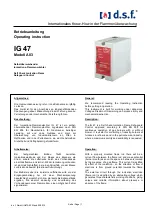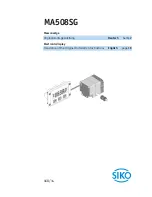
Dakota Ultrasonics
28
UNITS:
Toggle between English and Metric units and multiple resolutions for each
unit ( IN - .0001, INHR - .00001, or MM - .001, MMHR - .0001 ), Using the
abbreviation HR to represent High Resolution.
TYPE:
Select the bolt material type from a preset list of material types. Each type
contains a velocity, stress factor, and temperature factor. When a type is selected,
these values are displayed in the sub menu items below and can be edited by the
user at anytime.
VELOCITY:
This feature allows the user to edit the material velocity at anytime.
Once a material type is selected, the velocity of the selected material type is stored in
this sub menu item and can be edited a by the user if necessary.
STRESS FACTOR:
This feature allows the user to edit the stress factor at anytime.
Once a material type is selected, the stress factor of the selected material type is
stored in this sub menu item and can be edited by the user if necessary. Refer to
page 102 for further info.
TEMP COEF:
This feature allows the user to edit the material temperature coefficient
at anytime. Once a material type is selected, the temperature coefficient of the
selected material is stored in this sub menu item and can be edited by the user if
necessary. Refer to page 106 for further info.
4.4 GEOM (geometry) – Menu
QUANTITY:
Selectable units of measure in terms of TIME, ELONGATION, LOAD,
STRESS, and % STRAIN. Refer to page 127 for further info.
LOAD FACTOR:
The conversion factor from elongation to Load. This value is
typically determined by performing a field calibration and running a regression or
vector using the
MAX II
or utility software. Alternatively, the load factor can be
determined using the bolt calculator in the utility software. However, if extreme
accuracy is required, performing a field calibration is a must. This sub menu item
enables the user to edit the factor at anytime. Refer to page 109 for further info.
LOAD OFFSET:
Normally the Load Offset is set to zero. However, when a field
calibration is performed and regression calculated a small offset (y intercept) will
result. This value is a constant added or subtracted from the measurement, and will
result in correction to the load quantity. This sub menu item enables the user to edit
the offset value at anytime. Refer to page 109 for further info.
AREA:
The cross sectional area of the fastener being measured. Used to calculate
stress. Set to zero if the user is not measuring the quantity in terms of stress. This
Summary of Contents for MAX II
Page 2: ......
Page 7: ......
Page 8: ......
Page 54: ...Dakota Ultrasonics 46 Figure 6 Reflection in a bending bolt ...
Page 215: ......
















































